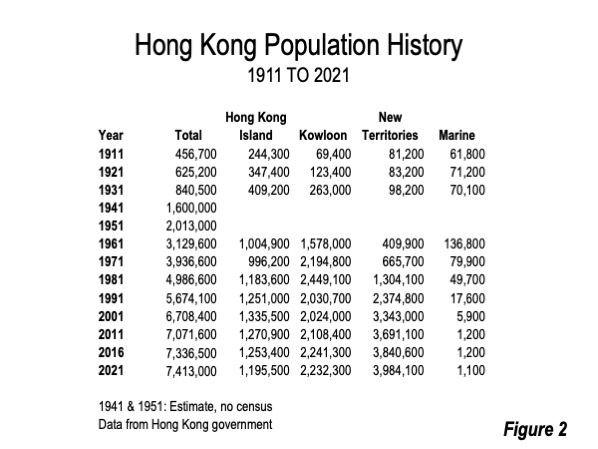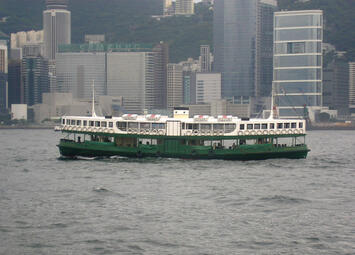
According to the 2021 census, Hong Kong grew from a population of 7.337 million in 2016 to 7.413 million. This article describes the population and population densities of Hong Kong and its major areas.
Hong Kong is the second densest urban area (a geography that excludes rural areas) with more than 1,000,000 residents and the densest among the large urban areas in the high-income world, at 23,000 per square kilometer or 58,000 per square mile. Yet despite the crowding, Hong Kong had achieved high income status by 1990, and exceeded Great Britain’s GDP per capita by that time. Hong Kong also ranked as the 10th densest urban area over 1,000,000 population in the world (Figure 1: District Map and Figure 2: Population History).
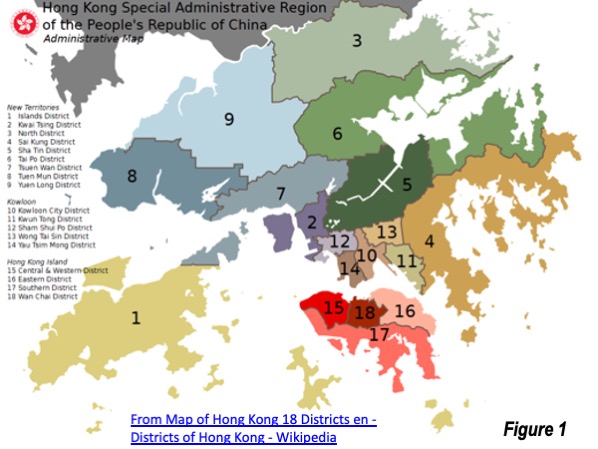
Hong Kong Island: Hong Kong Island includes the central business district (Figure 3), which is among the densest employment centers in the world, and with some of the tallest skyscrapers. Hong Kong Island used to be home to most of Hong Kong’s population, but has declined since 2001 from 1.336 million to 1.196 million, a loss of 10.5%. This urban core loss (reflected also below in Kowloon) is typical. Contrary to the press and popular notion that cities become denser as they grow, the opposite is largely true — urban core areas tend to lose population as cities grow both in China and elsewhere. In 2021, Hong Kong Island had a population density of 15,000 per square kilometer, or 38,700 residents per square mile, which is more than double that of the city of San Francisco.
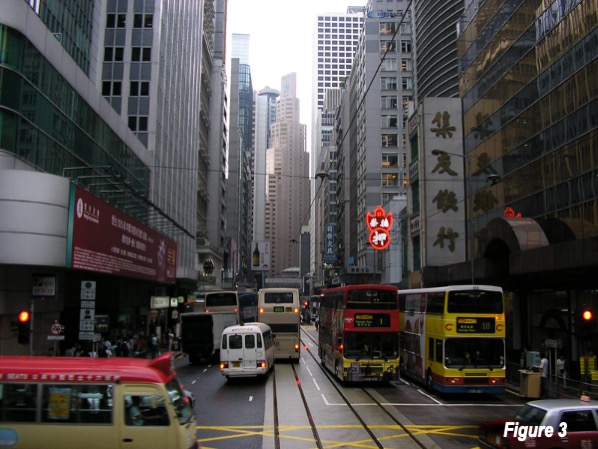
Kowloon: Kowloon, across Hong Kong harbor from Hong Kong Island had a population of 2.232 million, down slightly from 2016, and well below the 1981 census figure of 2.449 million (Figure 4). Kowloon had been the most populous area of Hong Kong from at least 1961 to 1981. Kowloon is the densest area in Hong Kong, with 47,600 per square kilometer or 123,200 per square mile. This is about double the density of New York’s Manhattan or the ville de Paris (inside the Boulevard Peripherique).
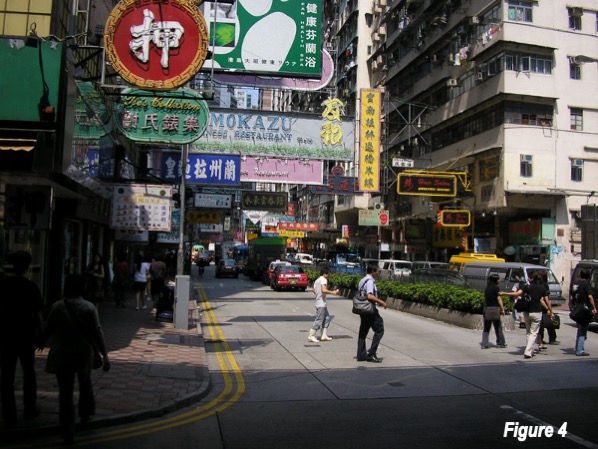
New Territories: Much of the new residential development for the last 50 years has been in the New Territories, which are between Kowloon on the south and the mainland China border (Shenzhen) on the north. By 1991, the new territories had exceeded the population of Kowloon. The 2021 census reported a population of just under 4 million. Since the last census (2016) the New Territories accounted for virtually all of Hong Kong’s population growth, adding 144,000, while the other areas lost a combined 67,000.
The New Territories has had more than half of the population of Hong Kong since at least the 2011 census. The new territories has a population density of 4,100 per square kilometer or 10,700 per square mile (The area density figures include the rural areas). There is considerable greenfield land in the New Territories which can be expected to continue growing its population faster than any other Hong Kong area. This is likely to be aided by the proposed Northern Metropolis that is being planned for a large area adjacent to the mainland China/Shenzhen (see Note below). A population of up to 2.5 million is being planned (Figure 5: New Territories, across the river where the new Northern Metropolis will be built, photo from Shenzhen).
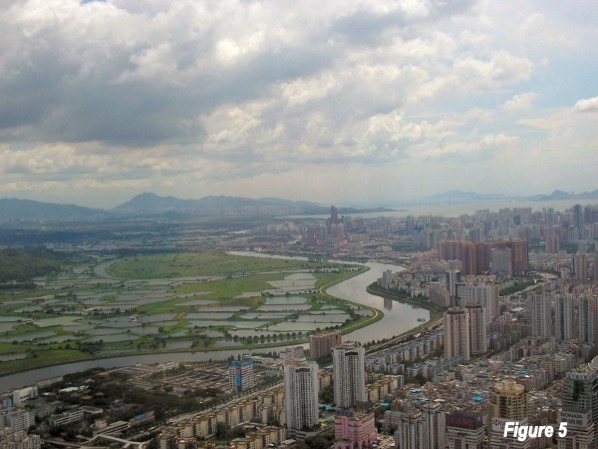
Marine: The marine population (living on boats) has been dropping for decades, having peaked at 137,000 in 1961 and now has around 1000 residence, a decline of 99%.
Hong Kong, The Future: It seems likely that Hong Kong will grow more slowly in the future, barring a massive infusion from the mainland. But as in China, Hong Kong suffers a very low Total Fertility Rate (TFR) of 0.772 children per woman of child-bearing years. This compares to South Korea, the lowest national rate, at 0.809, Macao (1.088), China (116.4) and Japan (1.300). Each of these World Bank 2021 TFRs is well below the replacement rate of 2.100.
In a word, Hong Kong’s future population seems likely to tilt further from its historic core. It may be more dense than any other Western urban area, but its trajectory follows the dispersion pattern common virtually everywhere.
Note: Shenzhen, which borders Hong Kong to the North, was a fishing village in the late 1970s, when it was established as a special economic region by the government of China. Shenzhen has grown to a population of nearly 18 million, as reported in the 2020 census. No city in world history has grown so much in so little time. Shenzhen is the fourth largest city in China, trailing only Shanghai, Beijing and Guangzhou, according to the 2020 census.
See also: Ultimate city” Guangdong – Hong Kong – Macao Greater Bay Area with Photographic Tour.
Wendell Cox is principal of Demographia, an international public policy firm located in the St. Louis metropolitan area. He is a founding senior fellow at the Urban Reform Institute, Houston, a Senior Fellow with the Frontier Centre for Public Policy in Winnipeg and a member of the Advisory Board of the Center for Demographics and Policy at Chapman University in Orange, California. He has served as a visiting professor at the Conservatoire National des Arts et Metiers in Paris. His principal interests are economics, poverty alleviation, demographics, urban policy and transport. He is co-author of the annual Demographia International Housing Affordability Survey and author of Demographia World Urban Areas.
Mayor Tom Bradley appointed him to three terms on the Los Angeles County Transportation Commission (1977-1985) and Speaker of the House Newt Gingrich appointed him to the Amtrak Reform Council, to complete the unexpired term of New Jersey Governor Christine Todd Whitman (1999-2002). He is author of War on the Dream: How Anti-Sprawl Policy Threatens the Quality of Life and Toward More Prosperous Cities: A Framing Essay on Urban Areas, Transport, Planning and the Dimensions of Sustainability.
Photograph: Star Ferry, between in Hong Kong Harbor between Hong Kong Island and Kowloon. There are also MTR (mass transit) and highway tunnels crossing the Harbor. All photos are by the author.
